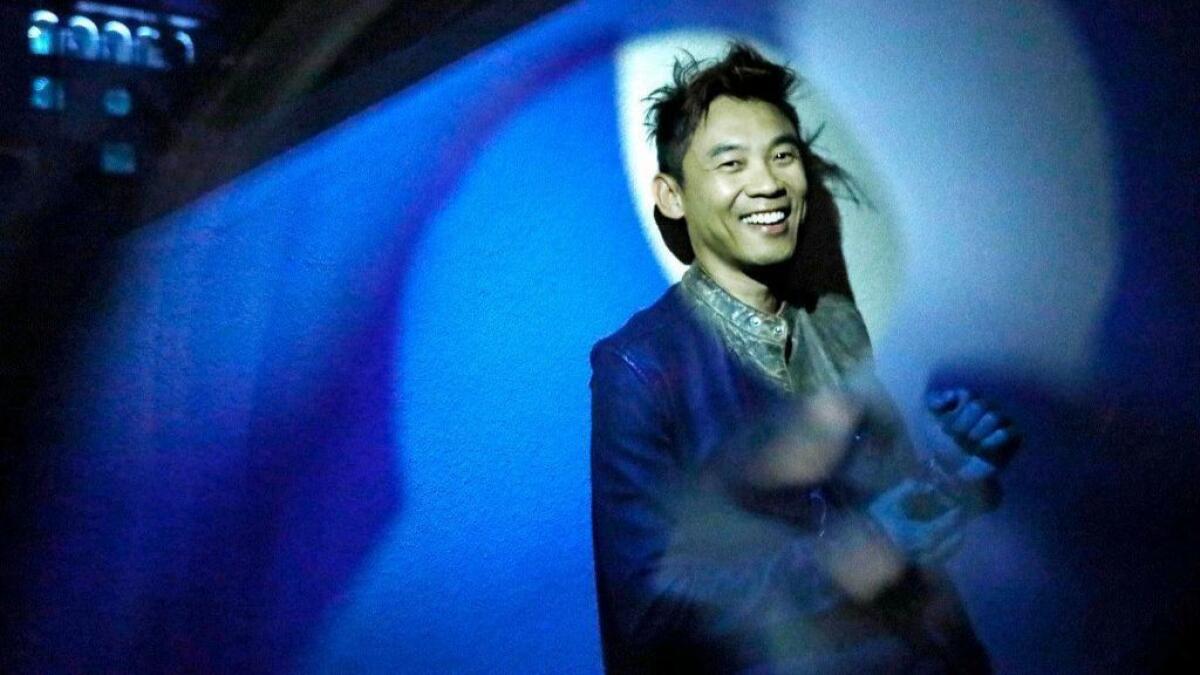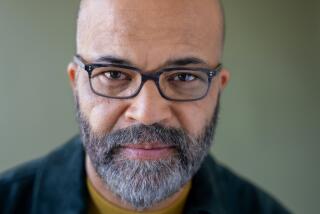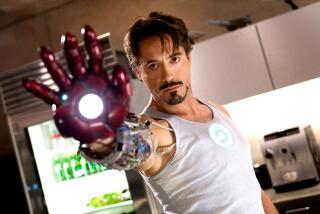‘Aquaman’ director James Wan: ‘I didn’t want to make a traditional superhero movie’

Just 48 hours ago, James Wan says, he was climbing the steep and winding steps of the Great Wall of China — a relatively relaxing exercise compared to the 14-hour a day, seven days a week pace he’d been grinding away at for the last three months to cross the finish line with “Aquaman,” the sixth film in Warner Bros.’ $3.8 billion DC Extended Universe treasure chest.
Today, thankfully, it’s teatime at the Peninsula Hotel in Beverly Hills. That means Wan, 41, can take a moment to marvel over the whirlwind journey that’s taken him around the world and back in a matter of days with “Aquaman,” which, by a very large measure, marks the biggest undertaking of his career.
“Filmmaking — the actual creative filmmaking — is only 40 or 50% of the process of making a movie in Hollywood,” says Wan, ordering a pot of Tahitian vanilla, the soft plinking of a harpist rising above the clinking of china. “The other 50-60% is navigating the big machinery of making these films.”
That journey still has a big hurdle to clear when “Aquaman,” starring Jason Momoa in a fresh spin on the aquatically gifted DC Comics superhero, opens Dec. 21 in the Christmas holiday frame. (It’s already off to a strong start in China, where the film, made for a reported $200 million, has outgrossed all previous DC titles — and most of the Marvel Cinematic Universe — in a single week.)
At that point Wan will be able to wind down from the wave he’s been riding for the last two and a half years.
“When the movie comes out, that’s when I’ll really go, whether people like it or not, ‘It’s out of my hands,’” he says with a smile.
The globe-trotting epic adventure, much of which is set beneath the sea among fantastically detailed ocean civilizations, with actors filmed “dry for wet” to create the illusion of being underwater, required an army of crew, artists and technicians to piece together.
Wan estimates that no shot has gone untouched by VFX, hence his insistence on tinkering around the clock until “the teacher basically says, ‘Put your pens down.’” Each floating wisp of hair, every spray of bubbles must be perfect, because even the tiny details help maintain the surreal credibility of the impossible world he’s built.
It was only 15 years ago that the Malaysian-born, Australian-grown filmmaker arrived in L.A. toting a seven-minute horror short made for $5,000 with filmmaker buddy Leigh Whannell. From those humble beginnings exploded “Saw,” the low-budget, $100 million box-office horror hit that launched both a franchise and Wan’s career.
The filmmaker has barely paused for breath since, establishing himself as Hollywood’s go-to master of frights as the director and producer behind the “Saw,” “Insidious” and “Conjuring” franchises. He stepped in to helm Universal’s “Furious 7,” leading a grief-stricken cast and crew to complete the action sequel in honor of the late Paul Walker following the actor’s death, and set up his own production company, Atomic Monster, at Warner Bros. ‘ New Line Cinema, continuing his streak of genre success.
And then came the chance to direct “Aquaman.”
There was plenty to the project that enticed Wan to join Warner Bros.’ DC franchise, which launched with Zack Snyder’s “Man of Steel” and the much gloomier “Batman v. Superman: Dawn of Justice.”
“The fact that Aquaman has never been seen on the big screen — you had that one shot of him in ‘Batman vs Superman’ – was exciting,” says Wan. “But let’s face it: There are so many superhero movies out there, and it seems like the marketplace is just full of superhero characters and films. If I were to go and make a movie like that, I needed it to feel unique.”
Wan readily says there are certain camp qualities native to the classic Aquaman, writ in the comics as a dashing blond super-merman with a dash of retro fantasy futurism. (HBO’s “Entourage” famously mocked the superhero and his big screen prospects.) The trick, says Wan, was to lean into it.
“He’s a guy that has been made fun of so much,” he laughs. “He’s been the butt of superhero jokes for the longest time. You kind of have to embrace it. That was my pitch from Day 1, and I never strayed from it… and to the studio’s credit, they left me alone to make the movie I wanted to make.”
Wan’s “Aquaman” is a superhero origin story with more than a few surprises up its sleeve.
For starters, its primary villain, Arthur’s Atlantean half-brother Orm (played by frequent Wan collaborator Patrick Wilson), seeks to rally the undersea kingdoms, seize the title of Ocean Master and declare war on humans in retaliation for their rampant pollution of the ocean — and who can really blame him?
Meanwhile, Wan gleefully populates his dazzling and expansive watery worlds with medieval mer-people, gargantuan crab monsters, drum-beating octopi, and the glorious sight of Dolph Lundgren riding a seahorse.
“I really embraced the more weird and wonderful aspect of it,” he grins, devouring a scone.
But following the success of DCEU’s trailblazing “Wonder Woman” standalone film, “Aquaman” also brings inclusivity and humanity to Momoa’s Pacific Islander Arthur Curry. “Justice League,” in which the character was formally introduced in 2017, was “kind of a weekend in Arthur’s life,” says Momoa, speaking by phone from Vancouver. “This is his whole story.”
The son of a lighthouse keeper (Temuera Morrison) and a rebellious princess of Atlantis (Nicole Kidman), beer-guzzling roadhouse regular Arthur is a part-time hero who can talk to fish, breathe underwater and command the oceans.
Having grown up half-human and half-Atlantean, feeling like an outsider in both lands — traveling to the high-tech underwater metropolis of Atlantis, he’s referred to as “half-breed” by his pale-skinned distant brethren — he’s also quite unsure of his place in the world.
“He’s jaded, more of a loner, not caring about the world as such, but then he realizes he has a greater purpose in life,” says Wan. The roguish hero with a sly sense of humor is also so Jason Momoa, he adds, which is exactly what “Aquaman” the movie needed.
“When I met him in person, I was like, he’s really funny,” says Wan. “He’s really charismatic. He was very rock ‘n’ roll, in T-shirts and jeans, and I’m like, ‘Dude, this is the side of you I want everyone to see.’ I felt like he had the makings of a movie star, and I wanted to try and bring that out.”
Embracing and celebrating Arthur’s background as a superhero of color was important to both Momoa and Wan, who cast fellow Aussie Nicole Kidman as Arthur’s mother, Atlanna, and New Zealander Temuera Morrison as his father, Thomas.
“Growing up in Australia and having tons of Maori and New Zealander friends, I was kind of familiar with that world,” Wan says.
At ‘Aquaman’ premiere, Jason Momoa proves ‘bringing culture to the carpet’ matters »
He even briefly contemplated changing Aquaman’s canonical hometown. “There was a moment when we thought, ‘What if Amnesty Bay is in New Zealand?’ Then, maybe not,” he laughs. “The fans might be upset if we move Amnesty Bay out of New England.”
The specificity makes “Aquaman” special and, often, surprisingly touching by superhero blockbusters standards.
Wan encouraged Momoa to infuse his performance with nods honoring Arthur’s Polynesian roots, and vividly recalls being inspired himself by an unplanned moment on set with Morrison.
“One day, when we were filming on set, Temuera just grabbed a stick — a staff that was lying against the wall — and he started doing a haka, spinning the stick,” says Wan. “I was watching, like, ‘Wow, this is so cool. I have to incorporate this into the movie somehow.’ ”
To represent his own culture onscreen in such a proud and prominent way “was a huge honor,” says Momoa, who made headlines this week leading a haka on the red carpet at “Aquaman’s” L.A. premiere. “Even when [“Justice League” director] Zack [Snyder] first thought about it, having tattoos, and being Polynesian… it was awesome to draw upon. I can’t tell you how honored I am.”
Arthur meets his match in the capable Atlantean warrior princess Mera, played by Amber Heard, who rebels from the warmongering King Orm’s court.
Phoning from New York, Heard praises Wan for shepherding an empowered depiction of Mera to the screen.
“He wasn’t interested in maintaining these sort of formulaic gender norms and stereotypes,” says Heard. “I go to the movies and I am bored with characters that are not complex … we as an audience and we as women deserve more.
“I feel lucky that James wanted to protect her integrity as an individual, badass, empowered strong woman — a superhero in her own right.”
To play the trickiest role in “Aquaman,” meanwhile, Wan looked to an old friend with whom he’d made five films to date, including the “Insidious” and “Conjuring” films. It started with a text message.
“We were doing ‘Conjuring 2’ and he said, ‘I’ve got something for you,’” remembers Wilson, “’Do you know the character of Ocean Master?’”
The first thing he saw when he looked up Orm was the fish-faced mask the stern villain wears. He was in. “I didn’t know if he’d be the main villain or the second villain or any of that, and I didn’t care,” says Wilson. “I knew if James asks me to do something, he’s going to put me to work and it’s going to be worth my time.”
As the character of Orm developed, he became central to the film’s not-so-subtle political themes, an eco-warrior who seeks to make the ocean great again.
“He’s very nationalistic, and Atlantis has a wall around it,” Wan says. “In an early draft, we went even further into that, but then I realized that it’s that fine line of not making it too political. I feel like I can do that because it’s part of the story, it’s part of the character, it’s part of the world of Atlantis.”
“When we started the film and had these ideas a couple of years ago, it was nice being out of the country,” says Wilson, who nevertheless downplays the degree to which the film is overtly political. “I don’t think we get on a soapbox.
“And look, comics throughout the years, from Stan Lee and from the beginning, have always echoed social issues, political issues, environmental issues. They always have. Many characters were created out of a desire to see change,” Wilson concludes. “So movies should do that, too.”
After “Aquaman,” his ninth feature as a director, Wan isn’t quite sure what he wants to direct next. He might take a break from directing — his “day job,” he jokes — to work on Atomic Monster’s slate of film and TV projects which include the company’s “Swamp Thing” television show for DC Universe.
“‘Aquaman’ ticks a lot of boxes for me,” he says. “For the longest time I wanted to do a movie that allowed me to do world creation. I didn’t want to make a traditional superhero movie, I wanted to make a fantasy movie.
“I’ll tell you this: When I wear my producer hat, I find myself to be a frustrated director,” he says. “I’ve got to hold myself back. I’m just the producer.”

James Wan details how he wants to change people’s perception of the famed superhero.
More to Read
Only good movies
Get the Indie Focus newsletter, Mark Olsen's weekly guide to the world of cinema.
You may occasionally receive promotional content from the Los Angeles Times.







